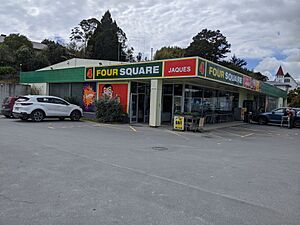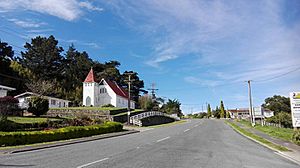Kaiwaka facts for kids
Quick facts for kids
Kaiwaka
|
|
|---|---|

Jaques Four Square supermarket
|
|
| Nickname(s):
The little town of lights
|
|
| Country | New Zealand |
| Region | Northland Region |
| District | Kaipara District |
| Ward | Kaiwaka-Mangawhai Ward |
| Electorates |
|
| Area | |
| • Total | 7.57 km2 (2.92 sq mi) |
| Population
(June 2023)
|
|
| • Total | 880 |
| • Density | 116.2/km2 (301.1/sq mi) |
Kaiwaka is a small town in the Northland area of New Zealand. It's often called "the little town of lights." The Kaiwaka River flows through the area from the east. It joins the Wairau River to create the Otamatea River. This river then flows into the large Kaipara Harbour.
State Highway 1, a main road, goes right through Kaiwaka. The town of Wellsford is about 20 km south. Brynderwyn is 8 km north. Whangārei, the closest city, is about 60 km north, which is a 45-minute drive. The popular Mangawhai Heads are 18 km northeast of Kaiwaka.
The name Kaiwaka means "eating the canoes" in Māori. This name might come from an old route between Kaiwaka and Mangawhai. This route connected the east coast with the Kaipara Harbour. People would carry their canoes across land here.
Local stories also talk about a special cloud seen only in this part of the Kaipara. It is believed to be a sign that an important person is about to pass away. The Māori saying is: He kapua pōuri ngā kaiwaka kei runga i te paerangi. He tohu aituā tēnei. This means: "Kaiwaka are threatening clouds on the horizon. This is a sign of misfortune."
Contents
History of Kaiwaka
Early History and Battles
In February 1825, a big battle happened near Kaiwaka. This was during the Musket Wars, a time when Māori tribes fought using muskets. Over 170 people died in this battle between the Ngāpuhi and Ngāti Whātua tribes.
European Settlement and Growth
From the late 1850s, Kaiwaka became a busy place for trade and business. At first, the main industries were kauri timber (wood from large trees) and kauri gum (a resin from kauri trees). As these industries slowed down, dairy farming became important. The Hakaru Dairy Company was started in 1902 to help local farmers.
From the 1880s, boats called steamers regularly traveled to Kaiwaka from the Otamatea. The Minnie Casey was one such boat, running a service every Tuesday from 1882. These boat services continued for many years.
The Great North Road from Auckland to Whangārei passed through Kaiwaka. However, for much of the 1800s, it was just a line on a map. Efforts to improve the road began in 1895. By 1900, the worst parts of the road between Kaiwaka and Whangārei were covered with metal. In 1911, Kaiwaka had 211 people living there.
The North Auckland railway line reached Kaiwaka in March 1913. Building the railway further north was difficult because of the land and World War I. So, it wasn't extended much more until the early 1920s.
In the 1940s, the government took over large areas of unused land. They developed these lands and gave them to soldiers returning from war in the early 1950s.
Te Pounga Marae
Kaiwaka is home to Te Pounga Marae and its meeting house. A marae is a traditional meeting place for Māori people. This marae is important for the Te Uri o Hau and Ngāti Whātua tribes. It is located on the central peninsula of Kaipara Harbour.
People of Kaiwaka
Population and Diversity
Kaiwaka is a rural settlement. In the 2023 New Zealand census, 783 people lived in Kaiwaka. This was an increase of 39 people since 2018. The median age in Kaiwaka was about 39.9 years.
About 21% of the people were under 15 years old. Most people in Kaiwaka are of European (Pākehā) background. About 28% identify as Māori. There are also people of Pasifika and Asian backgrounds. English is spoken by almost everyone. A small number of people also speak the Māori language.
About 24.5% of the people living in Kaiwaka were born outside New Zealand. Many people in Kaiwaka identify as having no religion. Others follow Christianity or Māori religious beliefs.
Notable People from Kaiwaka
- Mary Jane Mander: A journalist and writer who went to school in Kaiwaka.
- Tapihana Paraire Paikea: A Member of Parliament for the Northern Maori area, who passed away in Kaiwaka.
- Peter Panyoczki: A visual artist who lives in Kaiwaka.
Education
Kaiwaka School is a primary school for students in years 1 to 6. It teaches both boys and girls. The school first opened in September 1871. It celebrated its 100th birthday in 1970.
Geographic Features
Kaiwaka River
The Kaiwaka River is a key natural feature. It starts near the Kaiwaka town and flows west. It then joins with the Wairau River to form the Otamatea River. This river eventually flows into the large Kaipara Harbour.
Pukekaroro Scenic Reserve
Pukekaroro is a special mountain about 3.5 km north of Kaiwaka, right by State Highway 1. It's a forest-covered volcanic dome, shaped like a small hill, and is about 17 million years old. It rises to a height of 301 meters.
This mountain, called a maunga in Māori, is very important to the Te Uri o Hau tribe. From its top, you can see both the Mangawhai Heads to the east and the entrance to the Kaipara Harbour to the west. In the past, Te Uri o Hau used the trees from Pukekaroro to build waka (canoes) that were known for being very good at sea.
During the battle of Te Ika Ranganui in 1825, a chief named Karoro had a fortified village (pā) at the very top of Pukekaroro. He bravely carried many injured and deceased Te Uri o Hau people up the mountain. This was to keep them safe from the enemy. Pukekaroro is a very spiritual place for Te Uri o Hau because it has many wāhi tapu (sacred sites). The mountain has been considered sacred since that battle and still is today.



